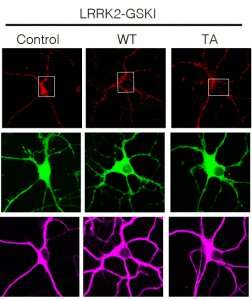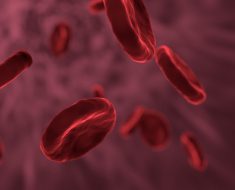
Mutations in a protein known to cause Parkinson’s Disease derange transportation in and out of brain cells, reports a team of UConn Health researchers in the 27 July issue of Science Signaling. The toxic traffic jams that result eventually lead to certain brain cell death and the characteristic symptoms of Parkinson’s.
“We figured out how LRRK2 causes dopaminergic neurodegeneration,” the break down and death of brain cells that control the movement of our body, says Yulan Xiong, a neuroscientist in UConn Health’s School of Medicine. LRRK2 is a gene that codes for a protein in our brain. The mutation affects a multi-step process and eventually causes protein to clog the doorways into the cell.
The columns in the picture above show brain cells with a specific mutation of LRRK2. Some of the cells are also making too much of a protein called AP2M1. WT are wild type, or normal, cells that express too much AP2M1; TA are cells that express too much of a mutant of AP2M1; and the control cells are cells that only carry the LRRK2 mutation, but make normal amounts of AP2M1 protein.
Xiong, neuroscience graduate student Qinfang Liu, UConn physiologist Jianzhong Yu, and other researchers on their team added a tracking molecule that glows red into the cells’ environment. The control cells absorbed the tracking molecule much more effectively than the WT and TA cells. You can see this in the image; their cell bodies (inside the white boxes in the pictures) glow much brighter red than the WT and TA cell bodies. This is because the WT and TA cells’ transportation networks were clogged by the extra AP2M1 protein together with the LRRK2 mutation.
Source: Read Full Article





